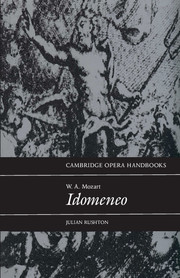Book contents
- Frontmatter
- Contents
- List of illustrations
- General preface
- Acknowledgements
- Introdution
- 1 Synopsis
- 2 Genesis of an operone
- 3 ‘Madame Dorothea Wendling is arcicontentissima’: the performers of Idomeneo
- 4 The genre of Idomeneo
- 5 From myth to libretto
- 6 Idomeneo after Mozart
- 7 General structure of Idomeneo
- 8 Two soliloquies
- 9 The musical language of Idomeneo
- 10 Tonality and motive
- 11 Elettra's first aria and the storm scene
- 12 Conclusions
- Notes
- Select bibliography
- Index
- Plate section
- Frontmatter
- Contents
- List of illustrations
- General preface
- Acknowledgements
- Introdution
- 1 Synopsis
- 2 Genesis of an operone
- 3 ‘Madame Dorothea Wendling is arcicontentissima’: the performers of Idomeneo
- 4 The genre of Idomeneo
- 5 From myth to libretto
- 6 Idomeneo after Mozart
- 7 General structure of Idomeneo
- 8 Two soliloquies
- 9 The musical language of Idomeneo
- 10 Tonality and motive
- 11 Elettra's first aria and the storm scene
- 12 Conclusions
- Notes
- Select bibliography
- Index
- Plate section
Summary
When he composed Idomeneo Mozart was not quite twenty-five, yet it is his tenth completed opera. It followed two serious operas, Mitridate, re di Ponto and Lucio Silla, written for Milan; the courtly allegories Ascanio in Alba and Il sogno di Scipione, for Milan and Salzburg; and Il rè pastore, for Salzburg in 1775. In these works there is scarcely a moment of levity: they deal in heroism, love, loyalty, magnanimity, and affairs of state. Despite two comedies written when he was twelve, and the Munich opera buffa La finta giardiniera, comedy played a comparatively small role in Mozart's early operatic output.
Idomeneo stands at a watershed in Mozart's career, but it also stands alone. It is the first of his mature operas rather than the last of his youth: thereafter he wrote only one opera seria, La clemenza di Tito. Idomeneo falls between two oriental adventure operas in German, the grave and unfinished Zaide (c. 1779) and Die Entführung aus dem Serail, performed in Vienna in 1782. It bears surprisingly little relationship in technique to the earlier Italian operas. Mitridate, Lucio Silla, and Il re pastore conform to the traditional type of opera seria in which there is no supernatural intervention; the plots are fiction, the characters historical, and the score consists almost entirely of recitative and arias. Idomeneo is based on classical mythology, and the drama depends on the intervention of a ‘real’ deity, the sea god Poseidon (Neptune); yet it is a richly human drama, not an allegory, and it makes abundant use of ballet, chorus, and scenic effects.
- Type
- Chapter
- Information
- W. A. Mozart: Idomeneo , pp. 1 - 3Publisher: Cambridge University PressPrint publication year: 1993



